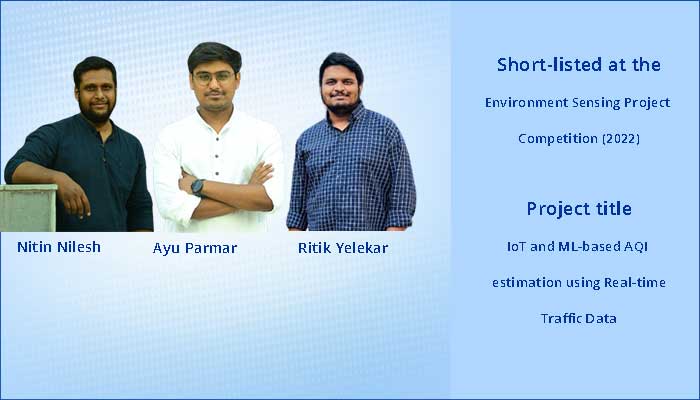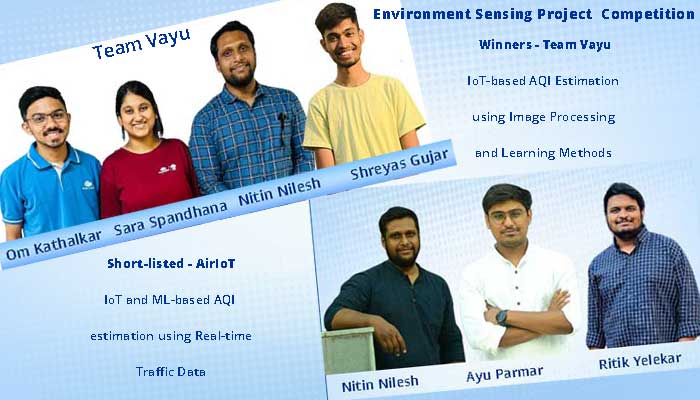At a contest organised by the University of Helsinki inviting participants to design, build, deploy and demonstrate an end-to-end solution on environmental sensing, IIITH’s submission that uses image-processing in conjunction with machine learning to estimate AQI levels walked away with the top prize.
The Environmental Sensing contest that was open to all students required them to test their abstract knowledge against complex real-life problems. Out of around 20-odd teams that participated, a total of 8 were shortlisted for evaluation in the final round by a separate team of jurors. IIITH’s winning team, “Vayu” comprising of Sara Spanddhana, Nitin Nilesh, Om Kathalkar, and Shreyash Gujar proposed a novel approach in lieu of the conventional air pollution monitoring systems that are sometimes bulky, high-cost, and high-power consuming, “The primary motivation of the project was to have an image-based air quality index (AQI) estimator,” says Nitin who is an MS by Research in CS student. With the competition allowing for on-going course projects and projects that are part of students’ thesis, Nitin’s working thesis that recommended an alternative air pollution monitoring system was submitted. Incidentally, it resulted in the publication of a paper titled, “IoT-based AQI Estimation Using Image Processing and Learning Methods” that was presented at the WF-IoT 2022 (the IEEE World Forum on Internet of Things).

Real-Life Pain Points
It was during the AirIoT project embarked upon by the Smart City Living Lab in collaboration with the Society for Cyberabad Security Council (SCSC) and the State Government of Telangana that the IIITH team experienced first-hand the drawbacks of conventional IoT sensor devices. “Initially in phase 2 of the project, we had deployed around 40-50 air pollution monitoring devices at a number of locations in the Gachibowli area but had to invest in at least a 100 more to replace the original thanks to their limited shelf life. The rate of failure of these conventional sensors is very high for a variety of reasons,” remarks Prof. Sachin Chaudhari who is leading the air pollution monitoring efforts at IIITH. The researchers realised that in order to scale it at the city-level, a more sustainable approach was needed.
The Way It Works
The team’s IoT-based solution which relies on a deep learning method along with image processing techniques uses features such as traffic density, and visibility obtained from images taken from a smartphone camera. These are then processed in conjunction with other features such as temperature and humidity obtained from nearby weather stations. Both these type of features are essential for estimating AQI. In order to create a dataset for training an ML model to estimate AQI, a car outfitted with the required hardware such as a dashcam, sensors to capture the features and a Raspberry Pi microcontroller unit was made to run on the streets of Hyderabad city. The front-facing camera was trained with air pollution data captured via the sensors. “Rather than giving a definitive AQI value, we trained our ML model to categorise air pollution into 5 different classes – Good, Satisfactory, Moderate, Poor and Severe,” says Sara, adding that this classification makes it more user-friendly when compared with continuous numbers, allowing denizens to take sufficient action. When tested out, the team reported an 82% accuracy in estimating AQI levels. Even when compared with existing research studies on image-based AQI detection, this method reported an improvement in accuracy of AQI estimation.
Second Shortlisted Team
Another team from SPCRC and the Smart City Research Centre named “AirIoT” comprising of Ayu Parmar, Nitin Nilesh and Ritik Yelekar also made it to the final round of the competition. Their motivation for coming up with an alternative to sensor-based air pollution detection stemmed from the same limitations of the aforementioned instruments. Hence they proposed a machine learning-based method of estimating AQI using real-time traffic data such as mobility rate of traffic, location data, weather information and the corresponding PM values.

Focus On Scalable Systems
According to Prof. Chaudhari, in the case of the image-based AQI estimator, the ultimate goal is that one should be able to detect pollution with mere camera images. “With this in mind, our solution can be implemented either on edge or on the cloud,” says Prof. Chaudhari. Expressing optimism about its scalability across cities, he continues, “In the near future, most cars will be equipped with dashcams. We could use those or the cameras mounted on traffic signals to understand the pollution levels of the entire city. That will be very interesting.” With Om and Shreyash – interns at the Signal Processing and Communication Research Centre (SPCRC) – extending this work by conducting a similar run in different cities, the possibilities look promising. “They are now collecting night-time data. Plus, while the original study used a front-facing camera, there are plans of using a back-facing camera next,” reports Prof. Chaudhari.



Next post